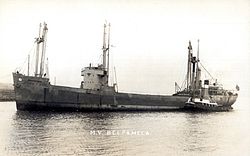Belpamela
|
||||||||||||||||||||||
|
||||||||||||||||||||||
|
||||||||||||||||||||||
|
||||||||||||||||||||||
|
||||||||||||||||||||||
The Belpamela was a heavy lift carrier for the Norwegian shipping company Belships . The ship sank on April 11, 1947 on the voyage from New York to Cherbourg in the Atlantic after the load of 16 locomotives had slipped due to bad weather.
The ship
The Belpamela was a heavy lift motor cargo ship with two thirds of the superstructure in the front and an engine located aft. She had two large holds with particularly large hatches and a reinforced tank ceiling. The ship, with a carrying capacity of around 4,500 tons, was prepared for the transport of extremely heavy or particularly bulky loads on deck. Accordingly, the loading gear consisted of six 5-tonne booms, one 30-tonne heavy-lift boom and one 100-tonne heavy-lift boom . For moving and stowing the bulky, heavy packages , the Belpamela was also equipped with rails in the hatches and several steam and electric winches on deck. The holds were separated by a removable bulkhead so that extra-long units could be stowed in the room.
history
Pre-war period

The Belpamela was built in February 1928 as hull number 1028 by the Armstrong-Whitworth shipyard in High Walker . She was the type ship of two identical ships of the shipping company. The ship was owned by Rederiet Belmoira A / S in Oslo, and the ship was managed by Christen Smith in Oslo. The ship was employed in the worldwide heavy lift transport. Typical cargoes consisted of locomotives and railcars, but lightships, lighters and other smaller watercraft, aircraft or industrial plants of all kinds, such as oil rigs, etc. were also carried. Due to the unusual loads, newspapers, magazines and occasionally also newsreels reported about the ship's operations. In October 1935 the ship was transferred to Skips A / S Belships Company Limited in Oslo, nothing changed in the management of Christen Smith. One notable cargo was a streamlined Coronation Scot train that the Belpamela transported from the UK to an exhibition in Baltimore in February 1939.
During the Second World War
In early March 1940, the Belpamela was ordered together with the Swedish steamer Lagaholm from Baltimore to Malmö by the Royal Navy units HMS Northern Sky and HMS Northern Princess to search for contraband to Kirkwall . In the early morning of March 2, the Belpamela was fired at by U 32 with three torpedoes, all of which detonated prematurely. In a second attack at 7.15 a.m., U 32 stopped the Lagaholm and sank it with the on-board cannon after its crew was in the lifeboats. This was picked up by the Belpamela and taken to Kirkwall and North Ronaldsay. On July 12, 1940, the Belpamela came under German control.
On April 2, 1945, mosquito fighter-bombers coming from Scotland attacked ships that were waiting for repairs at the Framnæs Mekaniske Værksted shipyard in Sandefjord . The ships Concordia and William Blumer were sunk, the Belpamela was damaged along with the ships Hektor , Shios Espana and Kattegat . The Belpamela was dragged to Oslo for repairs, where its completion was delayed until the end of the war due to an explosives attack.
post war period
After the end of the war, the ship was repaired and continued its worldwide heavy lift voyage. A large order from SNCF , which had ordered a total of 1,340 type 141 R ( Mikado ) locomotives from US and Canadian locomotive manufacturers to offset the war losses , took up particularly large space . In April 1947, the Belpamela was on a journey from New York to Cherbourg with 17 of these locomotives, numbers 1220 to 1235 and 1241 from the manufacturer Montreal Locomotive Works . On the Atlantic off the coast of Newfoundland , the ship got into severe bad weather, in which the locomotives slipped and the ship leaked. The ship sank at position 37 ° 44 ' N , 53 ° 3' W , killing nine crew members.
Web links
- Entry at derbysulzers (English)
- Entry at warsailors (English)
Individual evidence
- ↑ Announcement of the loss of the 17 Belpamela machines. Retrieved July 19, 2020 .
- ↑ 141R 1 à 1340. Accessed July 19, 2020 .

